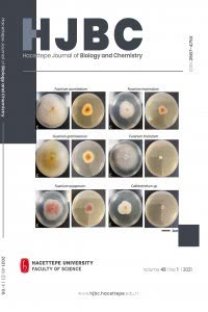Electrochemical Characterization of Carbonized Typha Tassel Modified Screen-Printed Electrode and Its Enzymatic Glucose Oxidation Application
Electrochemical Characterization of Carbonized Typha Tassel Modified Screen-Printed Electrode and Its Enzymatic Glucose Oxidation Application
___
- 1. H. Dai, Carbon Nanotubes: Synthesis, Integration, and Properties, Acc. Chem. Res., 35 (2002) 1035-1044.
- 2. I. Kondratowicz, M. Nadolska, S. Şahin, M. Łapiński, M. Prześniak-Welenc, M. Sawczak, H.Y. Eileen, W. Sadowski, and K. Żelechowska, Tailoring properties of reduced graphene oxide by oxygen plasma treatment, Appl. Surf. Sci., 440 (2018) 651-659.
- 3. S. Yang, Y. Li, S. Wang, M. Wang, M. Chu, and B. Xia, Advances in the use of carbonaceous materials for the electrochemical determination of persistent organic pollutants. A review, Microchim. Acta, 185 (2018) 112.
- 4. Y. Gao, L. Li, Y. Jin, Y. Wang, C. Yuan, Y. Wei, G. Chen, J. Ge, and H. Lu, Porous carbon made from rice husk as electrode material for electrochemical double layer capacitor, Appl. Energy, 153 (2015) 41-47.
- 5. A.M. Stephan, T.P. Kumar, R. Ramesh, S. Thomas, S.K. Jeong, and K.S. Nahm, Pyrolitic carbon from biomass precursors as anode materials for lithium batteries, Mater. Sci. Eng. A, 430 (2006) 132-137.
- 6. M. Saxena and S. Sarkar, Synthesis of carbogenic nanosphere from peanut skin, Diam. Relat. Mater., 24 (2012) 11-14.
- 7. N. Murugan and A.K. Sundramoorthy, Green synthesis of fluorescent carbon dots from Borassus flabellifer flowers for label-free highly selective and sensitive detection of Fe3+ions, New J. Chem., 42 (2018) 13297-13307.
- 8. D.K. Kamysbayev, B. Serikbayev, G. Arbuz, G. Badavamova, and K.S. Tasibekov, Synthesis and Electrochemical Behavior of the Molybdenum-Modified Electrode Based on Rice Husk, Eurasian Chem.-Technol. J., 19 (2017) 315-321.
- 9. D. Grieshaber, R. MacKenzie, J. Vörös, and E. Reimhult, Electrochemical Biosensors-Sensor Principles and Architectures, Sensors, 8 (2008) 1400.
- 10. G.Z. Garyfallou, O. Ketebu, S. Şahin, E. Mukaetova-Ladinska, M. Catt, and E. Yu, Electrochemical Detection of Plasma Immunoglobulin as a Biomarker for Alzheimer’s Disease, Sensors, 17 (2017) 2464.
- 11. S. Sahin, T. Wongnateb, P. Chaiyenb, and E.H. Yu, Glucose Oxidation Using Oxygen Resistant Pyranose-2-Oxidase for Biofuel Cell Applications, Chem. Eng. Trans., 41 (2014)
- 12. O.D. Renedo, M. Alonso-Lomillo, and M.A. Martínez, Recent developments in the field of screen-printed electrodes and their related applications, Talanta, 73 (2007) 202-219.
- 13. A. Heller, Miniature biofuel cells, Phys. Chem. Chem. Phys., 6 (2004) 209-216.
- 14. I. Willner, Y.M. Yan, B. Willner, and R. Tel-Vered, Integrated Enzyme -Based Biofuel Cells–A Review, Fuel Cells, 9 (2009) 7-24.
- 15. R. Wilson and A.P.F. Turner, Glucose oxidase: an ideal enzyme, Biosens Bioelectron., 7 (1992) 165-185.
- 16. G. Güven, S. Şahin, A. Güven, and E.H. Yu, Power Harvesting from Human Serum in Buckypaper-Based Enzymatic Biofuel Cell, Front. Energy Res., 4 (2016) 4.
- 17. S. Şahin, J. Merotra, J. Kang, M. Trenell, M. Catt, and E.H. Yu, Simultaneous electrochemical detection of glucose and non-esterified fatty Acids (NEFAs) for diabetes management, IEEE Sens J., 18 (2018) 9075-9080
- 18. S. Şahin, T. Wongnate, L. Chuaboon, P. Chaiyen, and E.H. Yu, Enzymatic fuel cells with an oxygen resistant variant of pyranose-2-oxidase as anode biocatalyst, Biosens Bioelectron., 107 (2018) 17-25.
- 19. E.H. Yu and K. Scott, Enzymatic biofuel cells-fabrication of enzyme electrodes, Energies, 3 (2010) 23.
- 20. S. Ferri, K. Kojima, and K. Sode, Review of glucose oxidases and glucose dehydrogenases: a bird’s eye view of glucose sensing enzymes, J. Diabetes Sci. Technol., 5 (2011) 1068-1076
- 21. I. Ivanov, T. Vidaković-Koch, and K. Sundmacher, Recent Advances in Enzymatic Fuel Cells: Experiments and Modeling, Energies, 3 (2010) 803.
- 22. J.K. Harkness, O.J. Murphy, and G.D. Hitchens, Enzyme electrodes based on ionomer films coated on electrodes, Journal of Electroanalytical Chemistry, 357 (1993) 261-272.
- 23. P. Stepnicka, Ferrocenes: ligands, materials and biomolecules, John Wiley & Sons, USA, 2008.
- 24. A. Erkal, İ. Aşık, S. Yavuz, A. Kariper, and Z. Üstündağ, Biosensor application of carbonaceous nanocoil material: preparation, characterization, and determination of dopamine and uric acid in the presence of ascorbic acid, J. Electrochem. Soc., 163 (2016) H269-H277.
- 25. B. Abderrahim, E. Abderrahman, M. Aqil, T. Fatima, T. Abdesselam, and O. Krim, Kinetic Thermal Degradation of Cellulose, Polybutylene Succinate and a Green Composite: Comparative Study, 2015
- 26. M. Naebe, J. Wang, A. Amini, H. Khayyam, N. Hameed, L.H. Li, Y. Chen, and B. Fox, Mechanical property and structure of covalent functionalised graphene/epoxy nanocomposites, Sci. Rep., 4 (2014) 4375.
- 27. X.H. Pham, M.P.N. Bui, C.A. Li, K.N. Han, J.H. Kim, H. Won, and G.H. Seong, Electrochemical characterization of a single-walled carbon nanotube electrode for detection of glucose, Analyt. chimica acta, 671 (2010) 36-40.
- ISSN: 2687-475X
- Yayın Aralığı: 4
- Başlangıç: 1972
- Yayıncı: Hacettepe Üniversitesi, Fen Fakültesi
Sunflower Stalk Based Activated Carbon for Supercapacitors
Semra GÜRBÜZ, Çiğdem ÖZENİRLER, Nazli MAYDA, Ömür GENÇAY ÇELEMLİ, Asli ÖZKÖK
Dürdane YİLMAZ, Dila KAYA, Kaan KEÇECİ, Ali DİNLER
Hasan Erdinç SELLİTEPE, Zeynep ÖZDEMİR, Mehmet Abdullah ALAGÖZ, İnci Selin DOĞAN, Didem KART
Pollen Spectrum of Some Honey Samples Produced in Siirt-Turkey
Nazlı MAYDA, Aslı ÖZKÖK, Semra GÜRBÜZ, Ömür Gençay ÇELEMLİ, Çiğdem ÖZENİRLER
